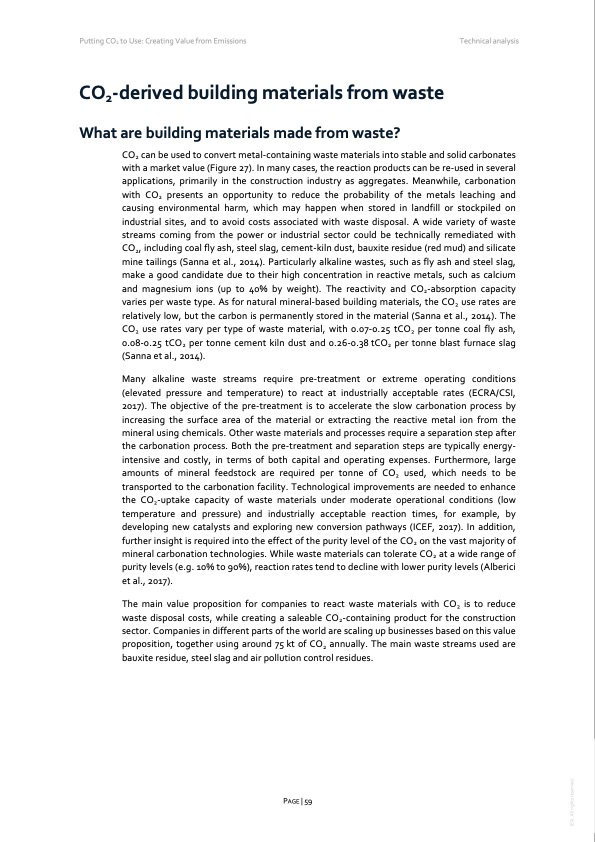
PDF Publication Title:
Text from PDF Page: 060
Putting CO2 to Use: Creating Value from Emissions Technical analysis CO2-derived building materials from waste What are building materials made from waste? CO2 can be used to convert metal-containing waste materials into stable and solid carbonates with a market value (Figure 27). In many cases, the reaction products can be re-used in several applications, primarily in the construction industry as aggregates. Meanwhile, carbonation with CO2 presents an opportunity to reduce the probability of the metals leaching and causing environmental harm, which may happen when stored in landfill or stockpiled on industrial sites, and to avoid costs associated with waste disposal. A wide variety of waste streams coming from the power or industrial sector could be technically remediated with CO2, including coal fly ash, steel slag, cement-kiln dust, bauxite residue (red mud) and silicate mine tailings (Sanna et al., 2014). Particularly alkaline wastes, such as fly ash and steel slag, make a good candidate due to their high concentration in reactive metals, such as calcium and magnesium ions (up to 40% by weight). The reactivity and CO2-absorption capacity varies per waste type. As for natural mineral-based building materials, the CO2 use rates are relatively low, but the carbon is permanently stored in the material (Sanna et al., 2014). The CO2 use rates vary per type of waste material, with 0.07-0.25 tCO2 per tonne coal fly ash, 0.08-0.25 tCO2 per tonne cement kiln dust and 0.26-0.38 tCO2 per tonne blast furnace slag (Sanna et al., 2014). Many alkaline waste streams require pre-treatment or extreme operating conditions (elevated pressure and temperature) to react at industrially acceptable rates (ECRA/CSI, 2017). The objective of the pre-treatment is to accelerate the slow carbonation process by increasing the surface area of the material or extracting the reactive metal ion from the mineral using chemicals. Other waste materials and processes require a separation step after the carbonation process. Both the pre-treatment and separation steps are typically energy- intensive and costly, in terms of both capital and operating expenses. Furthermore, large amounts of mineral feedstock are required per tonne of CO2 used, which needs to be transported to the carbonation facility. Technological improvements are needed to enhance the CO2-uptake capacity of waste materials under moderate operational conditions (low temperature and pressure) and industrially acceptable reaction times, for example, by developing new catalysts and exploring new conversion pathways (ICEF, 2017). In addition, further insight is required into the effect of the purity level of the CO2 on the vast majority of mineral carbonation technologies. While waste materials can tolerate CO2 at a wide range of purity levels (e.g. 10% to 90%), reaction rates tend to decline with lower purity levels (Alberici et al., 2017). The main value proposition for companies to react waste materials with CO2 is to reduce waste disposal costs, while creating a saleable CO2-containing product for the construction sector. Companies in different parts of the world are scaling up businesses based on this value proposition, together using around 75 kt of CO2 annually. The main waste streams used are bauxite residue, steel slag and air pollution control residues. PAGE | 59 IEA. All rights reserved.PDF Image | Putting CO2 to Use Creating value from emissions

PDF Search Title:
Putting CO2 to Use Creating value from emissionsOriginal File Name Searched:
putting_co2_to_use.pdfDIY PDF Search: Google It | Yahoo | Bing
NFT (Non Fungible Token): Buy our tech, design, development or system NFT and become part of our tech NFT network... More Info
IT XR Project Redstone NFT Available for Sale: NFT for high tech turbine design with one part 3D printed counter-rotating energy turbine. Be part of the future with this NFT. Can be bought and sold but only one design NFT exists. Royalties go to the developer (Infinity) to keep enhancing design and applications... More Info
Infinity Turbine IT XR Project Redstone Design: NFT for sale... NFT for high tech turbine design with one part 3D printed counter-rotating energy turbine. Includes all rights to this turbine design, including license for Fluid Handling Block I and II for the turbine assembly and housing. The NFT includes the blueprints (cad/cam), revenue streams, and all future development of the IT XR Project Redstone... More Info
Infinity Turbine ROT Radial Outflow Turbine 24 Design and Worldwide Rights: NFT for sale... NFT for the ROT 24 energy turbine. Be part of the future with this NFT. This design can be bought and sold but only one design NFT exists. You may manufacture the unit, or get the revenues from its sale from Infinity Turbine. Royalties go to the developer (Infinity) to keep enhancing design and applications... More Info
Infinity Supercritical CO2 10 Liter Extractor Design and Worldwide Rights: The Infinity Supercritical 10L CO2 extractor is for botanical oil extraction, which is rich in terpenes and can produce shelf ready full spectrum oil. With over 5 years of development, this industry leader mature extractor machine has been sold since 2015 and is part of many profitable businesses. The process can also be used for electrowinning, e-waste recycling, and lithium battery recycling, gold mining electronic wastes, precious metals. CO2 can also be used in a reverse fuel cell with nafion to make a gas-to-liquids fuel, such as methanol, ethanol and butanol or ethylene. Supercritical CO2 has also been used for treating nafion to make it more effective catalyst. This NFT is for the purchase of worldwide rights which includes the design. More Info
NFT (Non Fungible Token): Buy our tech, design, development or system NFT and become part of our tech NFT network... More Info
Infinity Turbine Products: Special for this month, any plans are $10,000 for complete Cad/Cam blueprints. License is for one build. Try before you buy a production license. May pay by Bitcoin or other Crypto. Products Page... More Info
| CONTACT TEL: 608-238-6001 Email: greg@infinityturbine.com | RSS | AMP |